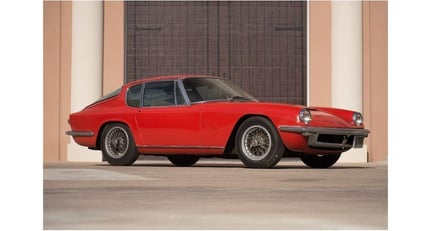1965 Maserati Mistral
3.7-
Baujahr3/1965
-
AutomobiltypCoupé
-
ChassisnummerAM109*314*
-
Elektrische FensterheberJa
-
LenkungLenkung links
-
ZustandRestaurierungsobjekt
-
Markenfarbe außen"Grigio Metallizzato" (Metallic Grey)
-
InnenfarbeBeige
-
Markenfarbe innen"Senape" (Tan)
-
InnenausstattungLeather
-
Anzahl der Türen2
-
Zahl der Sitze2
-
Standort

-
AußenfarbeRot
-
GetriebeManuell
-
Antrieb2wd
-
KraftstoffPetrol
Beschreibung
In classic Maseratis, each model holds a story, a unique blend of design, performance, and history. The Maserati Mistral 3.7, AM109*314*, is no exception. This car was finished on June 9, 1964 and first registered in March 1965 (as it served as a company demo car in Modena). Its original colours, "Grigio Metallizzato" (Metallic Grey) and "Senape" (Tan), add to its classic elegance. However, what makes this car truly intriguing is the mystery surrounding its early documentation. The Maserati Archive confirms this Maserati is a "Demo car" and believes its initial records were either not issued or lost, leaving only the "Avviso di Spedizione" when it was sold to Belgium as a used factory car.
The Maserati Mistral itself is a remarkable model. Introduced at the Torino Salone in November 1963 as a "Berlinetta 2 posti", it was immediately celebrated for its gorgeous design, a blend of Maserati elegance and speed. Designed by Pietro Frua, the Mistral was the first in a line of Maseratis named after winds, in this case, Le Mistral, that blows through France's Rhone river valley towards the Mediterranean. With a short chassis 10 centimetres shorter than the Sebring and a unique style, the Mistral stood out with its homogeneity, simplicity, and innovative features like the air intake under the full-width front bumper and an unusual hatchback configuration with a large glass panel.
The production of the Mistral was elaborate, involving several stages and subcontractors. The chassis, made by Maserati, was sent to Maggiora for body fitting, then to Officine Padane for pre-assembly, and finally back to Maserati for mechanical components and testing. The majority of Mistrals had a 3.7-litre engine, later evolving to 4 litres, and featured a Lucas fuel injection system, a ZF five-speed transmission, and options like air conditioning and a rare three-speed Borg-Warner automatic gearbox.
In total, 844 Mistrals were built between 1963 and 1969, marking the end of Maserati's inline 6-cylinder model evolution.













